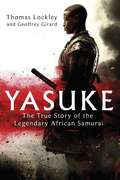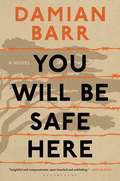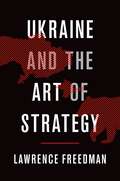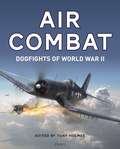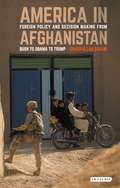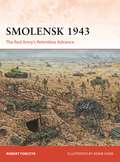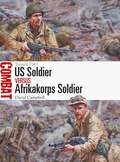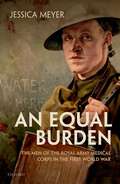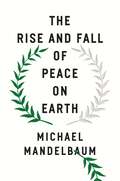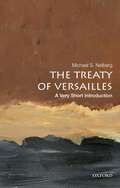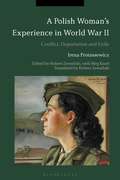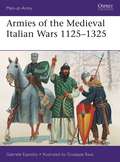- Table View
- List View
Yasuke: The true story of the legendary African Samurai
by Geoffrey Girard Thomas LockleyWARRIOR. SAMURAI. LEGEND.The remarkable life of history's first foreign-born samurai, and his astonishing journey from Northeast Africa to the heights of Japanese society.The man who came to be known as Yasuke arrived in Japan in the 16th century, an indentured mercenary arriving upon one of the Portuguese ships carrying a new language, a new religion and an introduction to the slave trade. Curiously tall, bald, massively built and black skinned, he was known as a steadfast bodyguard of immense strength and stature, and swiftly captured the interest, and thence the trust, of the most powerful family in all of Japan. Two years later, he vanished.Yasuke is the story of a legend that still captures the imagination of people across the world. It brings to life a little known side of Japan - a gripping narrative about an extraordinary figure in a fascinating time and place.
You Will Be Safe Here
by Damian BarrAn extraordinary debut that explores legacies of abuse, redemption, and the strength of the human spirit--from the Boer Wars in South Africa to brutal wilderness camps for teenage boys.South Africa, 1901. It is the height of the second Boer War. Sarah van der Watt and her six-year-old son Fred are forced from their home on Cherry Tree Farm. As the polite invaders welcome them to Bloemfontein Concentration Camp they promise Sarah and Fred that they will be safe there. 2014. Sixteen-year-old Willem is an outsider. Hoping he will become the man she wants him to be, his Ma and her boyfriend force Willem to attend the New Dawn Safari Training Camp where they are proud to make men out of boys. They promise that he will be safe there. You Will Be Safe Here is a powerful and urgent novel of two connected South African stories. Inspired by real events, it uncovers a hidden colonial history, reveals a dark contemporary secret, and explores the legacy of violence and our will to survive.
You'll Never See Me Again
by Lesley PearseHeart-pounding, exhilarating and ever suspenseful, No. 1 bestselling author Lesley Pearse's new novel is a tale of one woman's fight to find her destiny.WOMAN & HOME BEST BOOKS OF SUMMERBetty is running for her life . . . Young Betty dreams of settling down to an ordinary life with her husband. But when he returns broken and haunted from the Great War, she finds herself persecuted by his distraught mother - and yearns to escape.It is only when a storm devastates the village that Betty sees her chance. Fleeing to Bristol and changing her name to Mabel Brook, she seeks a new life - only to discover destiny has other plans.Penniless and alone, Mabel suffers a brutal attack before being rescued by a psychic named Nora Nightingale. She gets her first taste of those who receive messages from the dead and realizes she may have this power herself. But Mabel fears her gift may be a terrible curse as it becomes ever harder to hide from the truth about who she once was - and the tragic life she left behind. Soon Mabel receives her own message and is forced back to the very place she has escaped. A place of heartbreak and perhaps even murder - but to secure her future Mabel must confront her past one last time. Praise for Lesley Pearse: 'Storytelling at its very best' Daily Mail'Evocative, compelling, told from the heart' Sunday Express'Glorious, heart-warming' Woman & Home
Rorke's Drift and Isandlwana: Great Battles (Great Battles)
by Ian F. BeckettThis volume recounts the battles of Isandlwana and Rorke's Drift, exploring how they were fought, how they have been remembered, and what they mean for us today. The battle of Isandlwana on 22 January 1879, the first major battle in the Anglo-Zulu war, witnessed the worst single day's loss of British troops between the battle of Waterloo in 1815 and the opening campaignns of the First World War in August 1914. Moreover, decisive defeat at the hands of the Zulu came as an immense shock to a Victorian public that had become used to easy victories over less technologically advanced indigenous foes in an expanding empire. The successful defence of Rorke's Drift, which immediately followed the encounter at Isandlwana (and for which 11 Victoria Crosses were awarded), averted military disaster and went some way to restore wounded British pride, but the sobering memory of defeat at Isandlwana lingered for many years, while the legendary tale of the defence of Rorke's Drift was reawakened for a new generation in the epic 1964 film Zulu, starring Michael Caine. In this new volume in the Great Battles series, Ian F. W. Beckett tells the story of both battles, investigating not only their immediate military significance but also providing the first overarching account of their continuing cultural impact and legacy in the years since 1879, not just in Britain but also from the once largely inaccessible and overlooked Zulu perspective.
Ukraine and the Art of Strategy
by Lawrence FreedmanThe Russian invasion of Crimea in 2014, subsequent war in Eastern Ukraine and economic sanctions imposed by the West, transformed European politics. These events marked a dramatic shift away from the optimism of the post-Cold War era. The conflict did not escalate to the levels originally feared but nor was either side able to bring it to a definitive conclusion. Ukraine suffered a loss of territory but was not forced into changing its policies away from the Westward course adopted as a result of the EuroMaidan uprising of February 2014. President Putin was left supporting a separatist enclave as Russia's economy suffered significant damage. In Ukraine and the Art of Strategy, Lawrence Freedman-author of the landmark Strategy: A History-provides an account of the origins and course of the Russia-Ukraine conflict through the lens of strategy. Freedman describes the development of President Putin's anxieties that former Soviet countries were being drawn towards the European Union, the effective pressure he put on President Yanokvych of Ukraine during 2013 to turn away from the EU and the resulting 'EuroMaidan Revolution' which led to Yanukovych fleeing. He explores the reluctance of Putin to use Russian forces to do more that consolidate the insurgency in Eastern Ukraine, the failure of the Minsk peace process and the limits of the international response. Putin's strategic-making is kept in view at all times, including his use of 'information warfare' and attempts to influence the American election. In contrast to those who see the Russian leader as a master operator who catches out the West with bold moves Freedman sees him as impulsive and so forced to improvise when his gambles fail. Freedman's application of his strategic perspective to this supremely important conflict challenges our understanding of some of its key features and the idea that Vladimir Putin is unmatched as a strategic mastermind.
Air Combat: Dogfights of World War II
by Dmitriy Khazanov Aleksander Medved Edward M. Young Tony HolmesThe battle for the skies in World War II fuelled a race between rival air forces to develop ever faster and more capable fighter aircraft – and the struggle for air superiority was never over until the war itself ended. This volume explores four clashes of some of the finest planes and pilots, in key theatres of the war: Spitfires duelling the formidable Bf 109 over the Channel, the Fw 190 battling the Soviet La 5 and 7 on the Eastern Front, the F4F Wildcat in a desperate clash with the legendary A6M Zero-sen, and the F4U Corsair in combat with the second-generation Japanese Ki-84 in the closing days of the war.Fully illustrated with contemporary photographs, maps and colour artwork, Air Combat conveys the full story behind these dramatic aviation duels.
America in Afghanistan: Foreign Policy and Decision Making From Bush to Obama to Trump (Library of Modern Middle East Studies)
by Sharifullah DoraniAfghanistan has been a theatre of civil and international conflict for much of the twentieth century – stability is essential if there is to be peace in the Greater Middle East. Yet policy-makers in the West often seem to forget the lessons learned from previous administrations, whose interventions have contributed to the instability in the region. Here, Sharifullah Dorani focuses on the process of decision-making, looking at which factors influenced American policy-makers in the build-up to its longest war, the Afghanistan War, and how reactions on the ground in Afghanistan have influenced events since then. America in Afghanistan is a new, full history of US foreign policy toward Afghanistan from Bush's 'War on Terror', to Obama's war of 'Countering Violent Extremism' to Trump's war against 'Radical Islamic Terrorism'. Dorani is fluent in Pashto and Dari and uses unique and unseen Afghan source-work, published here for the first time, to understand the people in Afghanistan itself, and to answer their unanswered questions about 'real' US Afghan goals, the reasons for US failures in Afghanistan, especially its inability to improve governance and stop Pakistan, Iran and Russia from supporting the insurgency in Afghanistan, and the reasons for the bewildering changes in US Afghan policy over the course of 16 and a half years. To that end the author also assesses Presidents Karzai and Ghani's responses to Bush, Obama and Trump's policies in Afghanistan and the region. In addition, the book covers the role Afghanistan's neighbours – Russia, Iran, India, and especially Pakistan – played in America's Afghanistan War. This will be an essential book for those interested in the future of the region, and those who seek to understand its recent past.
Hellcat vs Shiden/Shiden-Kai: Pacific Theater 1944–45 (Duel)
by Tony HolmesBy the early months of 1944 in the Pacific, the US Navy's burgeoning force of carrier-based F6F-3/5 Hellcats had pretty much wiped the skies clear of Japanese fighters during a series of one-sided aerial engagements. However, starting in October they faced the superb Kawanishi N1K1/2 Shiden/Shiden-Kai, a formidable fighter with improved armament, a powerful engine and excellent manoeuvrability that in contrast to earlier Japanese fighters had the ability to withstand a greater degree of battle damage.Japanese pilots using this aircraft would claim more than 170 aerial victories over Kyushu and whilst escorting Kamikazes attacking Allied ships off Okinawa. US Navy Hellcat pilots in turn were credited with many of the scores of Shiden-Kais that were downed attempting to defend Japan. This fully illustrated book compares these two fascinating aircraft, using specially commissioned artwork, first-hand accounts and a thorough technical analysis.
Ju 88 Aces of World War 2 (Aircraft of the Aces)
by Jim Laurier Robert Forsyth Mark PostlethwaiteInitially designed as a fast medium bomber, the Junkers Ju 88 was also used as a Zerstörer heavy fighter by the Luftwaffe. It saw its combat debut over Poland in 1939, and heavy fighter variants saw action on every front up to VE Day. The ultimate Ju 88 fighter variant was the G-model of 1944, which boasted a FuG 220 or 227 radar, an astounding array of cannon and machine gun armament and advanced Junkers Jumo or BMW engines. A dedicated nightfighter, the first Ju 88G-1s entered service with the Nachtjagd in the summer of 1944, replacing Ju 88C/Rs as well as some Bf 110Gs. Despite suffering heavy losses in the final months of the war, Ju 88Gs also inflicted serious casualties on Bomber Command throughout the war.From patrolling over the Bay of Biscay, to the Arctic circle opposing Allied convoys and, most successfully, as radar-equipped nightfighters engaging RAF heavy bombers during defence of the Reich operations from late 1941, this is the story of the Ju 88 aces who menaced Allied aircraft and shipping throughout World War 2.
The Khazars: A Judeo-Turkish Empire on the Steppes, 7th–11th Centuries AD (Men-at-Arms)
by David Nicolle Mikhail ZhirohovThe Khazars were one of the most important Turkic peoples in European history, dominating vast areas of southeastern Europe and the western reaches of the Central Asian steppes from the 4th to the 11th centuries AD. They were also unique in that their aristocratic and military elites converted to Judaism, creating what would be territorially the largest Jewish-ruled state in world history. They became significant allies of the Byzantine Empire, blocking the advance of Islam north of the Caucasus Mountains for several hundred years. They also achieved a remarkable level of metal-working technology, and their military elite wore forms of iron plate armour that would not be seen in Western Europe until the 14th century. The Khazar state provided the foundations upon which medieval Russia and modern Ukraine were built. Fully illustrated with detailed colour plates, this is a fascinating study into the armies, organisation, armour, weapons and fortifications of the Khazars.
Rebels and Patriots: Wargaming Rules for North America: Colonies to Civil War (Osprey Wargames)
by Michael Leck Daniel MerseyFrom the first shots at Jumonville Glen to the surrender at Appomattox, Rebels and Patriots allows you to campaign with Wolfe or Montcalm, stand with Tarleton at Cowpens or Washington at Yorktown, or don the blue or grey to fight for Grant or Lee. From the French and Indian War, through the War of Independence and the War of 1812, to the Alamo and the American Civil War, these rules focus on the skirmishes, raids, and small engagements from this era of black powder and bayonet. Your Company is commanded by your Officer during these tumultuous conflicts. Each battle that your Officer faces allows him to develop new and interesting traits. Does he perform heroically and earn a nom de guerre? Or falter, to be forever known as a yellow-belly? Designed by Michael Leck and Daniel Mersey, with a core system based on the popular Lion Rampant rules, Rebels and Patriots provides all the mechanics and force options needed to recreate the conflicts that forged a nation.
Smolensk 1943: The Red Army's Relentless Advance (Campaign)
by Robert Forczyk Adam Hook Bounford.com Bounford.com Paul KimeWith the German defeat at Kursk, the Soviet Stavka (high command) ordered the Western and Kalinin Fronts to launch Operation Suvorov in order to liberate the city of Smolensk. The Germans had held this city for two years and Heeresgruppe Mitte's (Army Group Centre) 4. Armee had heavily fortified the region. The Soviet offensive began in August 1943 and they quickly realized that the German defences were exceedingly tough and that the Western Front had not prepared adequately for an extended offensive. Consequently, the Soviets were forced to pause their offensive after only two weeks, in order to replenish their combat forces and then begin again. The German 4. Armee was commanded by Generaloberst Gotthard Heinrici, one of the Wehrmacht's top defensive experts. Although badly outnumbered, Heinrici's army gamely held off two Soviet fronts for seven weeks. Eventually, the 4. Armee's front was finally broken and Smolensk was liberated on 25 September 1943. However, the Western Front was too exhausted to pursue Heinrici's defeated army, which retreated to the fortified cities of Vitebsk, Orsha and Mogilev; the 4. Armee would hold these cities until the destruction of Army Group Centre in June 1944. Operation Suvorov focuses on a major offensive that is virtually unknown in the West and which set the stage for the decisive defeat of Heeresgruppe Mitte in the next summer offensive.
US Soldier vs Afrikakorps Soldier: Tunisia 1943 (Combat)
by David CampbellOperation Torch, launched on 8 November 1942, landed Anglo-American forces in Vichy-controlled Morocco and Algeria to create a second front against the Axis forces in North Africa, catching Rommel's German and Italian forces in the claws of a giant pincer. The US Army was powerfully well armoured and equipped, but fresh to war, and it showed. Organization suffered from a surfeit of peacetime theories and training was insufficient and ill-applied. Despite such failings the US GIs and their commanders learned very quickly, adapting to German tactics and the realities of mechanized warfare. The Axis forces in North Africa were seasoned by years of fighting against increasingly powerful British and Commonwealth forces, and were led by one of the Reich's most capable generals. The German doctrine of mechanized warfare had proved itself time and again, but ever-growing logistical and supply problems were blunting its effectiveness. From Sidi Bou Zid to El Guettar, this fully illustrated study pits the US Army against the best that the Axis forces in Africa had to offer.
Weapons of the Viking Warrior (Weapon)
by Gareth WilliamsBetween the late 8th and late 11th century Viking warriors had a massive impact not just in northern Europe, but across a huge arc from the western Mediterranean round through northern Europe and the Baltic to the Middle East and Central Asia. Their success depended in part on their skills in battle, their unique sense of strategic mobility, and on the quality of their weapons and equipment. Written by an expert on early medieval weaponry, this book examines the weapons of the typical Viking warrior, dispels some of the myths of the popular image, such as double-headed axes, and considers the range of weapons that actually underpinned the Vikings' success including bows and arrows.Drawing upon contemporary literary and historical accounts from the North Atlantic to the Arab world, surviving examples of weapons and armour, and practical experimentation and reconstructions by modern weapon-smiths and re-enactors, this study casts new light on how Viking weapons were made and used in battle.
An Equal Burden: The Men of the Royal Army Medical Corps in the First World War
by Jessica MeyerThis is an open access title available under the terms of a CC BY-NC-ND 4.0 International licence. It is free to read at Oxford Scholarship Online and offered as a free PDF download from OUP and selected open access locations. An Equal Burden is the first scholarly study of the Army Medical Services in the First World War to focus on the roles and experiences of the men of the Royal Army Medical Corps (RAMC). Though they were not professional medical caregivers, they were called upon to provide urgent medical care and, as non-combatants, were forbidden from carrying weapons. Their role in the war effort was quite unique and warranting of further study. Structured both chronologically and thematically, An Equal Burden examines the work that RAMC rankers undertook and its importance to the running of the chain of medical evacuation. It additionally explores the gendered status of these men within the medical, military, and cultural hierarchies of a society engaged in total war. Through close readings of official documents, personal papers, and cultural representations, Meyer argues that the ranks of the RAMC formed a space in which non-commissioned servicemen, through their many roles, defined and redefined medical caregiving as men's work in wartime.
The Rise and Fall of Peace on Earth
by Michael MandelbaumIn the twenty-five years after 1989, the world enjoyed the deepest peace in history. In The Rise and Fall of Peace on Earth, the eminent foreign policy scholar Michael Mandelbaum examines that remarkable quarter century, describing how and why the peace was established and then fell apart. To be sure, wars took place in this era, but less frequently and on a far smaller scale than in previous periods. Mandelbaum argues that the widespread peace ended because three major countries -- Vladimir Putin's Russia in Europe, Xi Jinping's China in East Asia, and the Shia clerics' Iran in the Middle East -- put an end to it with aggressive nationalist policies aimed at overturning the prevailing political arrangements in their respective regions. The three had a common motive: their need to survive in a democratic age with their countries' prospects for economic growth uncertain. Mandelbaum further argues that the key to the return of peace lies in the advent of genuine democracy, including free elections and the protection of religious, economic, and political liberty. Yet, since recent history has shown that democracy cannot be imposed from the outside, The Rise and Fall of Peace on Earth has a dual message: while the world has a formula for peace, there is no way to ensure that all countries will embrace it.
The Treaty of Versailles: A Very Short Introduction (Very Short Introductions)
by Michael S. NeibergSigned on June 28, 1919 between Germany and the principal Allied powers, the Treaty of Versailles formally ended World War I. Problematic from the very beginning, even its contemporaries saw the treaty as a mediocre compromise, creating a precarious order in Europe and abroad and destined to fall short of ensuring lasting peace. At the time, observers read the treaty through competing lenses: a desire for peace after five years of disastrous war, demands for vengeance against Germany, the uncertain future of colonialism, and, most alarmingly, the emerging threat of Bolshevism. A century after its signing, we can look back at how those developments evolved through the twentieth century, evaluating the treaty and its consequences with unprecedented depth of perspective. The author of several award-winning books, Michael S. Neiberg provides a lucid and authoritative account of the Treaty of Versailles, explaining the enormous challenges facing those who tried to put the world back together after the global destruction of the World War I. Rather than assessing winners and losers, this compelling book analyzes the many subtle factors that influenced the treaty and the dominant, at times ambiguous role of the "Big Four" leaders: Woodrow Wilson of the United States, David Lloyd George of Great Britain, Vittorio Emanuele Orlando of Italy, and Georges Clémenceau of France. The Treaty of Versailles was not solely responsible for the catastrophic war that crippled Europe and the world just two decades later, but it played a critical role. As Neiberg reminds us, to understand decolonization, World War II, the Cold War, and even the complex world we inhabit today, there is no better place to begin than with World War I and the treaty that tried, and perhaps failed, to end it. ABOUT THE SERIES: The Very Short Introductions series from Oxford University Press contains hundreds of titles in almost every subject area. These pocket-sized books are the perfect way to get ahead in a new subject quickly. Our expert authors combine facts, analysis, perspective, new ideas, and enthusiasm to make interesting and challenging topics highly readable.
Imperial Military Transportation in British Asia: Burma 1941-1942
by Michael W. CharneyImperial Military Transportation in British Asia sheds light on attempts by royal engineers to introduce innovations devised in the UK to wartime India, Iraq, and Burma, as well as the initial resistance of local groups of colonial railwaymen to such metropolitan innovations. Michael W. Charney looks at the role of the railways in the First Burma Campaign to show how some kinds of military technology – as an example of imperial knowledge – faced resistance due to 1930s-era colonial insularity. The delay this caused significantly compromised the early defense of the colony when the Japanese invaded in 1942. Charney examines the efforts made by one engineer in particular to revive the railways and shows how this effort was responsible for the development of a truly imperial technology that was suitable for extra-European contexts and finally won acceptance in India. Incorporating newly accessible primary source material from the files of the military Director of Transportation during the Campaign, this book highlights a hitherto unfilled gap in the archival record and explores an ignored but crucial aspect of the 1942 Japanese invasion of Burma.
A Polish Woman’s Experience in World War II: Conflict, Deportation and Exile
by Irena Protassewicz Hubert Zawadzki Meg KnottThis hitherto unpublished first-hand witness account, written in 1968-9, tells the story of a privileged Polish woman whose life was torn apart by the outbreak of the Second World War and Soviet occupation. The account has been translated into English from the original Polish and interwoven with letters and depositions, and is supplemented with commentary and notes for invaluable historical context. Irena Protassewicz's vivid account begins with the Russian Revolution, followed by a rare insight into the life and mores of the landed gentry of northeastern Poland between the wars, a rural idyll which was to be shattered forever by the coming of the Second World War. Deported in a cattle truck to Siberia and sentenced to a future of forced labour, Irena's fortunes were to change dramatically after Hitler's attack on Russia. She charts the adventure and horror of life as a military nurse with the Polish Army, on a journey that would take her from the wastes of Soviet Central Asia, through the Middle East, to an unlikely ending in the highlands of Scotland. The story concludes with Irena's search to discover the wartime and post-war fate of her family and friends on both sides of the Iron Curtain, and the challenges of life as a refugee in Britain. A Polish Woman's Experience in World War II provides a compelling, personal route into understanding how the greatest conflict of the 20th century transformed the lives of the individuals who lived through it.
Armies of the Medieval Italian Wars 1125–1325 (Men-at-Arms #523)
by Giuseppe Rava Gabriele EspositoThe great powers of medieval Europe fought continuously in the Italian peninsula between the 12th and 14th centuries as they sought to expand their territory. Invading armies from Germany – the Holy Roman Empire – saw the creation of the defensive Lombard League of northern Italian city-states. These struggles resulted in conflicts between rival confederacies, which in turn proved to be the catalysts for developments in organisation and tactics. Italian urban militias became better organised and equipped, the Imperial armies went from being mostly German to multi-national forces, and both sides became reliant on mercenary forces to prosecute their wars. After the 1260s, France, relying mainly on armoured cavalry, and Spain, with their innovative light infantry, vied for control of southern Italy. On the seas, the great naval powers of Genoa, Pisa and Venice became fierce rivals, as they created great trading empires, bringing the treasures of the east into feudal Europe. Using detailed colour plates, this beautifully illustrated book describes the myriad of armies and navies that fought for control of Italy in the Middle Ages.
Chinese Battleship vs Japanese Cruiser: Yalu River 1894 (Duel #92)
by Paul Wright Benjamin Lai Alan GillilandThe 1894–95 war between China and Japan, known in the West as the First Sino-Japanese War, lasted only nine months, but its impact resonates today. The Chinese Beiyang (Northern) Fleet was led by her flagship, Dingyuan, and her sister ship, Zhenyuan, which were the biggest in Asia; German-built armoured turret ships, they were armed with four 12in guns and two 6in guns, plus six smaller guns and three torpedo tubes. For their part the Japanese fleet, including the Matsushima and her sister ships Itsukushima and Hashidate, were each armed with a single 12.6in Canet gun and 11 or 12 4.7in guns, plus smaller guns and four torpedo tubes. The scene was set for a bloody confrontation that would stun the world and transform the relationship between China and Japan.Fully illustrated with stunning artwork, this is the engrossing story of the Yalu River campaign, where Chinese and Japanese ironclads fought for control of Korea.
French Armour in Vietnam 1945–54 (New Vanguard #267)
by Henry Morshead Simon DunstanFrench experience with armour in Indo-China dated back to 1919, when it sent FT-17s to the colony, followed by a variety of armoured cars. After World War II, French troops were equipped with a motley collection of American and cast-off British equipment until the outbreak of war in Korea saw an increase in military aid. This included large numbers of the M24 Chaffee light tank, along with amphibious vehicles such as the M29C Weasel and LVT4 Buffalo, to conduct operations in coastal and inland areas that the Viet Minh had previously thought immune to attack. France's armour was a key part of the battle against the Viet Minh right up until the last stand at Dien Bien Phu.
How to Survive in the Georgian Navy: A Sailor's Guide
by Bruno PappalardoRigidly organised and harshly disciplined, the Georgian Royal Navy was an orderly and efficient fighting force which played a major role in Great Britain's wars of the 18th and early 19th centuries. This concise book explores what it was like to be a sailor in the Georgian Navy – focusing on the period from 1714 to 1820, this book examines the Navy within its wider historical, national, organisational and military context, and reveals exactly what it took to survive a life in its service. It looks at how a seaman could join the Royal Navy, including the notorious 'press gangs'; what was meant by 'learning the ropes'; and the severe punishments that could be levied for even minor misdemeanours as a result of the Articles of War. Military tactics, including manning the guns and tactics for fending off pirates are also revealed, as is the problem of maintaining a healthy diet at sea – and the steps that sailors themselves could take to avoid the dreaded scurvy. Covering other fascinating topics as wide-ranging as exploration, mutiny, storms, shipwrecks, and women on board ships, this 'Sailor's Guide' explores the lives of the Navy's officers and sailors, using extracts from contemporary documents and writings to reconstruct their experiences in vivid detail.
Japan 1944–45: LeMay’s B-29 strategic bombing campaign (Air Campaign #9)
by Paul Wright Mark Lardas Adam Tooby Bounford.com Bounford.com Paul KimeThe air campaign that incinerated Japan's cities was the first and only time that independent air power has won a war.As the United States pushed Imperial Japan back towards Tokyo Bay, the US Army Air Force deployed the first of a new bomber to the theater. The B-29 Superfortress was complex, troubled, and hugely advanced. It was the most expensive weapons system of the war, and formidably capable. But at the time, no strategic bombing campaign had ever brought about a nation's surrender. Not only that, but Japan was half a world away, and the US had no airfields even within the extraordinary range of the B-29. This analysis explains why the B-29s struggled at first, and how General LeMay devised radical and devastating tactics that began to systematically incinerate Japanese cities and industries and eliminate its maritime trade with aerial mining. It explains how and why this campaign was so uniquely successful, and how gaps in Japan's defences contributed to the B-29s' success.
Northrop Flying Wings (X-Planes #10)
by Adam Tooby Peter E. DaviesHalf a century before the 'flying wing' B-2 stealth bomber entered service, John K. 'Jack' Northrop was already developing prototypes of a large 'flying wing' strategic bomber, which would have been the most radical bombers of their age. World War II brought a need for very long-range bombers and Northrop received a contract for a 172-ft span bomber, the B-35. Several of these were built, gradually evolving into the definitive XB-35 configuration. Testing revealed that the aircraft was invisible to radar, but engineers struggled to overcome the design challenges and several pilots were lost in crashes. While the program was cancelled in the 1950s, the concept extended into other highly innovative areas, such as the XP-56 and MX-324 Rocket Wing prototype fighters. But the greatest legacy was the first operational flying wing – the Northrop Grumman B-2 stealth bomber, which used much of the hard-won experience from the pioneering programs of half a century before.
